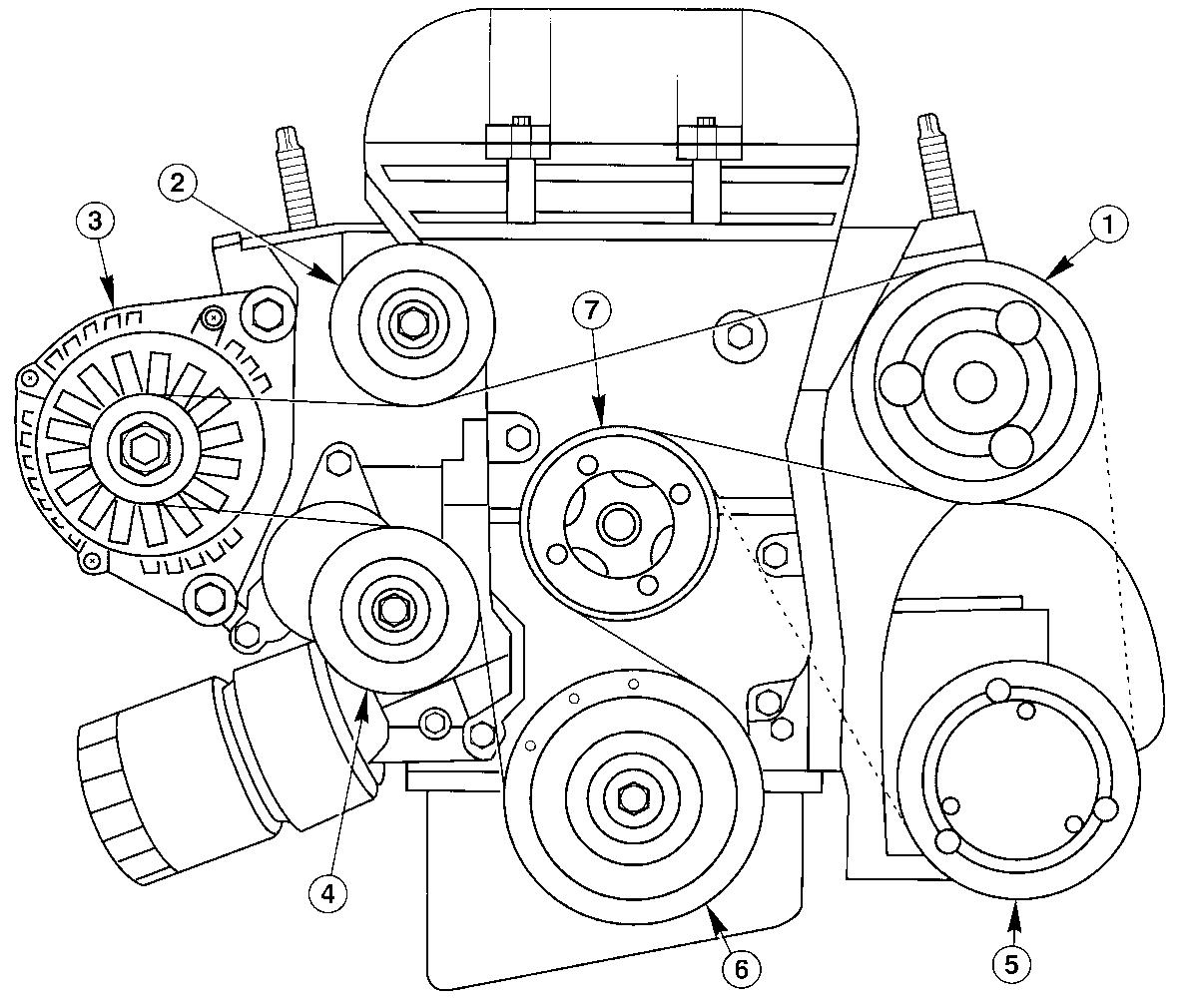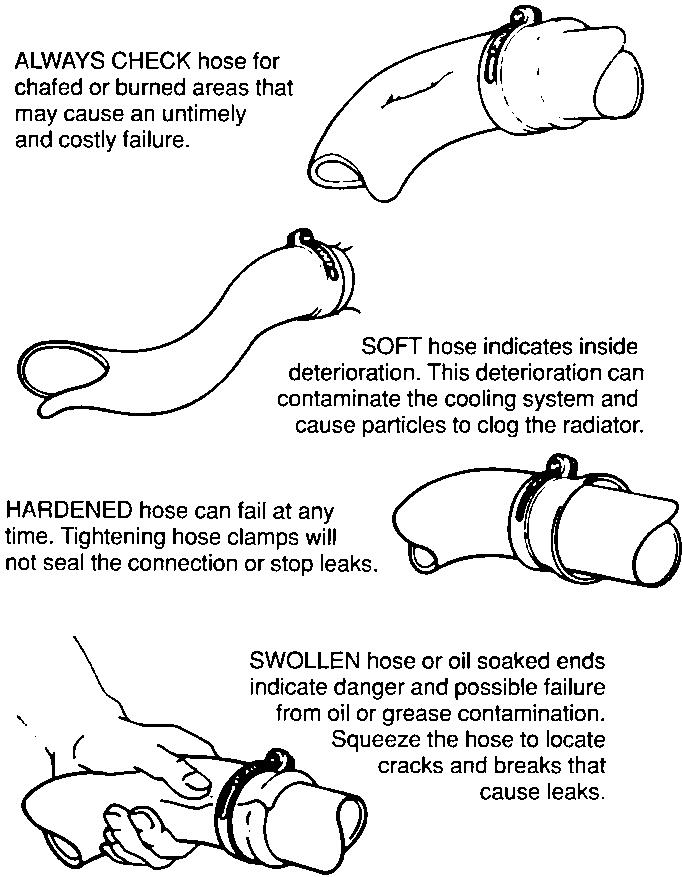
9 minute read
Renew the coolant (Sections 2 and
11.11A When installing the auxiliary drivebelt, make sure that it is centred - it must not overlap either edge of the grooved pulleys 11.11B Auxiliary drivebelt routing
being felt when its pulley is rotated clockwise, and a smooth return to the limit of its travel when released. 11 If the original drivebelt is being refitted, use the marks or notes made on removal, to ensure that it is installed to run in the same direction as it was previously. To fit the drivebelt, arrange it on the grooved pulleys so that it is centred in their grooves, and not overlapping their raised sides (note that the flat surface of the drivebelt is engaged on the idler, tensioner and water pump pulleys) and routed correctly (see illustrations). Start at the top, and work down to finish at the crankshaft pulley; rotate the tensioner pulley clockwise, slip the drivebelt onto the crankshaft pulley, then release the tensioner again. 12 Using a spanner applied to the crankshaft pulley bolt, rotate the crankshaft through at least two full turns clockwise to settle the drivebelt on the pulleys, then check that the drivebelt is properly installed. 13 Refit the auxiliary drivebelt cover and roadwheel, then lower the vehicle to the ground.
12 Underbonnet check for fluid leaks and hose condition
Caution: Renewal of air conditioning hoses must be left to a dealer service department or air conditioning specialist who has the equipment to depressurise the system safely. Never remove air conditioning components or hoses until the system has been depressurised.
1 Power steering pump 2 Idler pulley 3 Alternator 4 Automatic tensioner 5 Air conditioning compressor (when fitted) 6 Crankshaft pulley 7 Water pump pulley
General
1 High temperatures in the engine compartment can cause the deterioration of the rubber and plastic hoses used for engine, accessory and emission systems operation. Periodic inspection should be made for cracks, loose clamps, material hardening and leaks. 2 Carefully check the large top and bottom radiator hoses, along with the other smallerdiameter cooling system hoses and metal pipes; do not forget the heater hoses/pipes which run from the engine to the bulkhead, and those to the engine oil cooler (where fitted). Inspect each hose along its entire length, replacing any that is cracked, swollen or shows signs of deterioration. Cracks may become more apparent if the hose is squeezed (see illustration). If you are using non-Ford specification antifreeze, and so have to renew the coolant every two years or so, it’s a good idea to renew the hoses at that time, regardless of their apparent condition. 3 Make sure that all hose connections are tight. A leak in the cooling system will usually show up as white- or rust-coloured deposits on the areas adjoining the leak; if the spring clamps that are used to secure the hoses in this system appear to be slackening, they should be renewed to prevent the possibility of leaks. 4 Some other hoses are secured to their fittings with clamps. Where clamps are used, check to be sure they haven’t lost their tension, allowing the hose to leak. If clamps aren’t used, make sure the hose has not expanded and/or hardened where it slips over the fitting, allowing it to leak.

12.2 Hoses, like drivebelts, have a habit of failing at the worst possible time - to prevent the inconvenience of a blown radiator or heater hose, inspect them carefully as shown here
5 Check all fluid reservoirs, filler caps, drain plugs and fittings etc, looking for any signs of leakage of oil, transmission and/or brake hydraulic fluid, coolant and power steering fluid. If the vehicle is regularly parked in the same place, close inspection of the ground underneath it will soon show any leaks; ignore the puddle of water which will be left if the air conditioning system is in use. As soon as a leak is detected, its source must be traced and rectified. Where oil has been leaking for some time, it is usually necessary to use a steam cleaner, pressure washer or similar, to clean away the accumulated dirt, so that the exact source of the leak can be identified. Vacuum hoses
6 It’s quite common for vacuum hoses, especially those in the emissions system, to be colour-coded, or to be identified by coloured stripes moulded into them. Various systems require hoses with different wall thicknesses, collapse resistance and temperature resistance. When renewing hoses, be sure the new ones are made of the same material. 7 Often the only effective way to check a hose is to remove it completely from the vehicle. If more than one hose is removed, be sure to label the hoses and fittings to ensure correct installation. 8 When checking vacuum hoses, be sure to include any plastic T-fittings in the check. Inspect the fittings for cracks, and check the hose where it fits over the fitting for distortion, which could cause leakage. 9 A small piece of vacuum hose (quarter-inch inside diameter) can be used as a stethoscope to detect vacuum leaks. Hold one end of the hose to your ear, and probe around vacuum hoses and fittings, listening for the “hissing” sound characteristic of a vacuum leak. Warning: When probing with the vacuum hose stethoscope, be very careful not to come into contact with moving engine components such as the auxiliary drivebelt, radiator electric cooling fan, etc. Fuel hoses
Warning: There are certain precautions which must be taken when inspecting or servicing fuel system components. Work in a wellventilated area, and do not allow open flames (cigarettes, appliance pilot lights, etc.) or bare light bulbs near the work area. Mop up any spills immediately, and do not store fuel-soaked rags where they could ignite. 10 Check all fuel hoses for deterioration and chafing. Check especially for cracks in areas where the hose bends, and also just before fittings, such as where a hose attaches to the fuel filter. 11 High-quality fuel line, usually identified by the word “Fluoroelastomer” printed on the hose, should be used for fuel line renewal. Never, under any circumstances, use unreinforced vacuum line, clear plastic tubing or water hose for fuel lines. 12 Spring-type clamps are commonly used on fuel lines. These clamps often lose their tension over a period of time, and can be “sprung” during removal. Replace all spring-type clamps with screw clamps whenever a hose is replaced. Metal lines
13 Sections of metal piping are often used for fuel line between the fuel filter and the engine. Check carefully to be sure the piping has not been bent or crimped, and that cracks have not started in the line. 14 If a section of metal fuel line must be renewed, only seamless steel piping should be used, since copper and aluminium piping don’t have the strength necessary to withstand normal engine vibration. 15 Check the metal brake lines where they enter the master cylinder and ABS hydraulic unit (if used) for cracks in the lines or loose fittings. Any sign of brake fluid leakage calls for an immediate and thorough inspection of the brake system.
1 With the vehicle parked on level ground, apply the handbrake firmly and open the bonnet. Using an inspection light or a small electric torch, check all visible wiring within and beneath the engine compartment. 2 What you are looking for is wiring that is obviously damaged by chafing against sharp edges, or against moving suspension/ transmission components and/or the auxiliary drivebelt, by being trapped or crushed between carelessly-refitted components, or melted by being forced into contact with the hot engine castings, coolant pipes, etc. In almost all cases, damage of this sort is caused in the first instance by incorrect routing on reassembly after previous work has been carried out. 3 Depending on the extent of the problem, damaged wiring may be repaired by rejoining the break or splicing-in a new length of wire, using solder to ensure a good connection, and remaking the insulation with adhesive insulating tape or heat-shrink tubing, as appropriate. If the damage is extensive, given the implications for the vehicle’s future reliability, the best long-term answer may well be to renew that entire section of the loom, however expensive this may appear. 4 When the actual damage has been repaired, ensure that the wiring loom is rerouted correctly, so that it is clear of other components, and not stretched or kinked, and is secured out of harm’s way using the plastic clips, guides and ties provided. 5 Check all electrical connectors, ensuring that they are clean, securely fastened, and that each is locked by its plastic tabs or wire clip, as appropriate. If any connector shows external signs of corrosion (accumulations of white or green deposits, or streaks of “rust”), or if any is thought to be dirty, it must be unplugged and cleaned using electrical contact cleaner. If the connector pins are severely corroded, the connector must be renewed; note that this may mean the renewal of that entire section of the loom - see your local Ford dealer for details. 6 If the cleaner completely removes the corrosion to leave the connector in a satisfactory condition, it would be wise to pack the connector with a suitable material which will exclude dirt and moisture, preventing the corrosion from occurring again; a Ford dealer may be able to recommend a suitable product. 7 Check the condition of the battery connections - remake the connections or renew the leads if a fault is found (see Chapter 5). Use the same techniques to ensure that all earth points in the engine compartment provide good electrical contact through clean, metal-to-metal joints, and that all are securely fastened. (In addition to the earth connection at the engine lifting eye, and that from the transmission to the body/battery, there are one or two earth points behind each headlight assembly, and one below the power steering fluid reservoir.) 8 Refer to Section 31 for details of spark plug (HT) lead checks.
13 Engine compartment wiring check
14 Air conditioning system check
Warning: The air conditioning system is under high pressure. Do not loosen any fittings or remove any components until after the system has been discharged. Air conditioning refrigerant must be properly discharged into an approved type of container, at a dealer service department or an automotive air conditioning repair facility capable of handling R134a refrigerant. Always wear eye protection when disconnecting air conditioning system fittings. 1 The following maintenance checks should be performed on a regular basis, to ensure that the air conditioner continues to operate at peak efficiency: (a) Check the auxiliary drivebelt. If it’s worn or deteriorated, renew it (see Section 11). (b) Check the system hoses. Look for cracks, bubbles, hard spots and deterioration.
Inspect the hoses and all fittings for oil bubbles and seepage. If there’s any evidence of wear, damage or leaks, renew the hose(s). (c) Inspect the condenser fins for leaves, insects and other debris. Use a “fin




